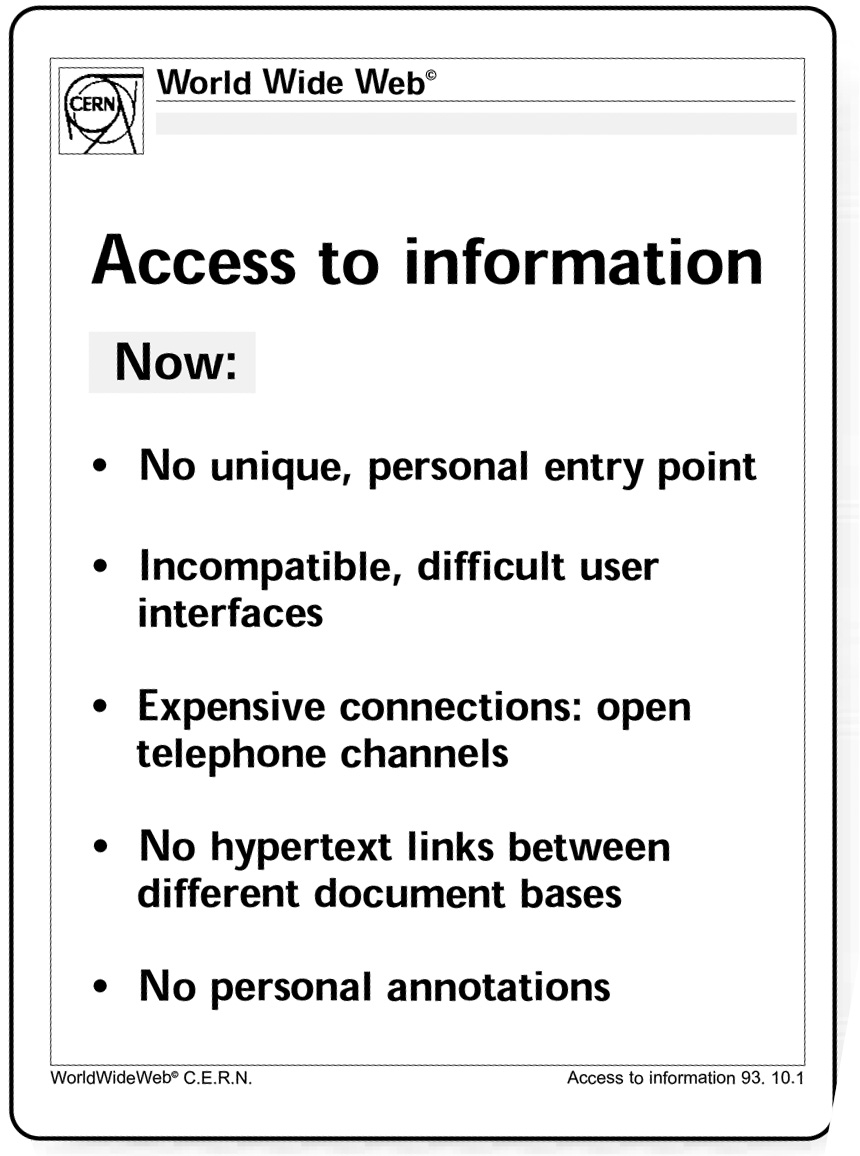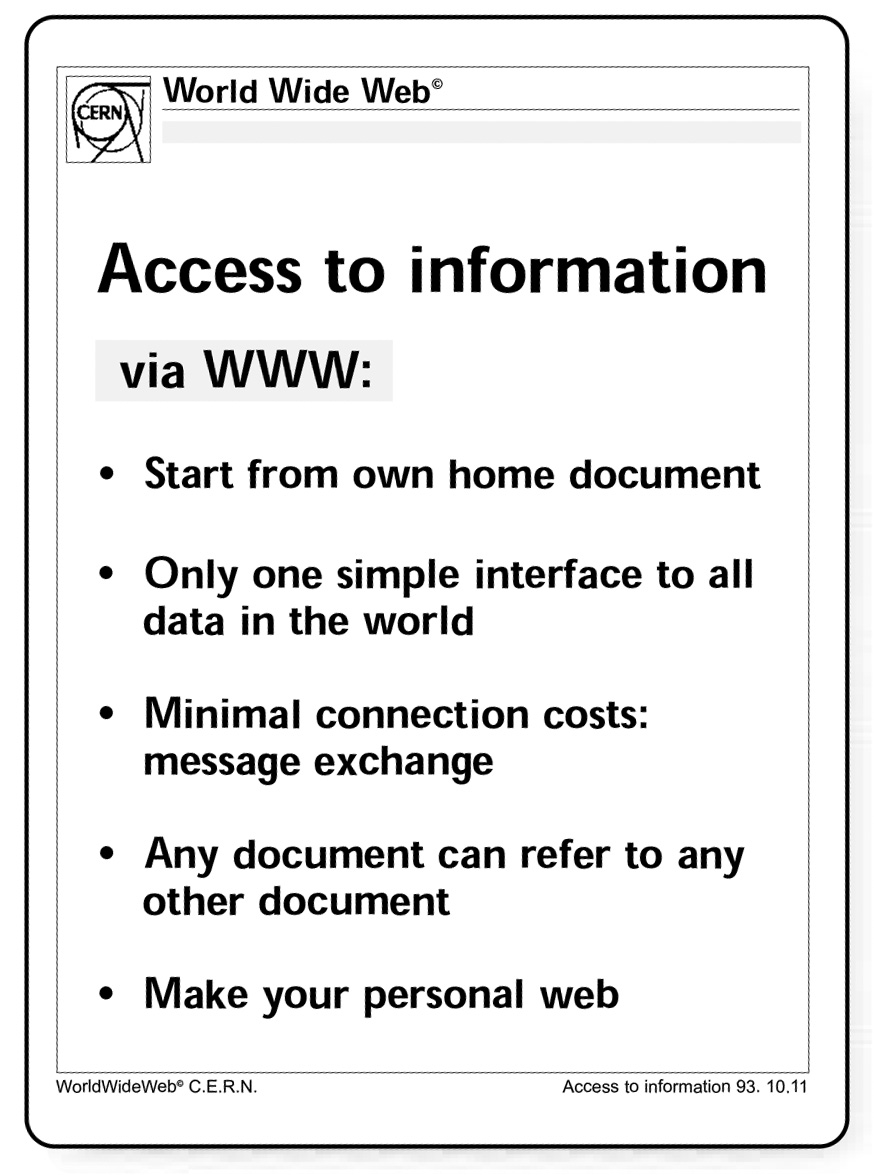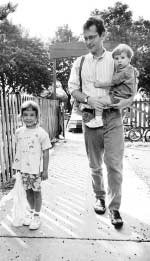High-Energy Physics: Birthplace of the Web
In mid-1991, when it spun its first thread from CERN to Fermilab, hardly anyone had ever heard of the World Wide Web. Now, only four years later, the Web is woven through the fabric of our culture, connecting people all over the planet in a new medium of communication. But of the millions who type “http://www....” each day, how many realize that—like the universe itself—it all began with high-energy physics?
What started out as tool for far-flung scientific colleagues to share each others’ data may ultimately count among high-energy physics’ most significant contributions to modern technology.
The Web was born in 1990, when Tim Berners-Lee, a computer scientist at CERN, the European Laboratory for Particle Physics, programmed the first types of computer codes, called protocols, that allowed a computer anywhere to contact any other computer and communicate unfettered by log-in accounts and database incompatibilities.
“He’s someone who thinks very clearly about the fundamentals, but besides this, he happened to come upon his idea at the right time,” said Ruth Pordes, Computing Division Online Systems Department head. “His idea was to make distributed information over a network easily accessible to the whole world, and to work out the protocol of how to do that.”
In its infancy, an internal laboratory version of the Web allowed high-energy physicists at CERN to share data and papers within their own network, but it remained difficult to connect to outside servers—from CERN to Fermilab for example—to share documents with other scientists.
Pordes, who had met Berners-Lee at international meetings, invited him to visit Fermilab for a few weeks in January, 1991. The visit coincided with a conference on hypertext, familiar to most Internet users as the “link” function of Web browsers. The conference gave Berners-Lee a stimulus for developing his ideas.
Berners-Lee returned to Fermilab in 1992. During his visit he made the first one-click link between the CERN server and Fermilab’s central computers.
“We installed it (the CERN Web server) on FNALV and we linked it up to the documents used for data-taking and later analyses,” Pordes said.
Fermilab’s Jonathan Streets, leader of the Experiments Online Support Group, helped Berners-Lee set up the system.
“He and I wrote the server on FNALV that served the documents,” Streets said. “Now anybody could come in and get them. That was the first time anybody could use the same interface to read documents pertaining to both data-taking and analyses—because we had very different databases.”
Before Berners-Lee wrote the hypertext transfer protocols each computer server generally required a separate log-in account and had a different documentation system, making smooth communication between systems difficult. Berners-Lee’s software (the Web), broke down the barriers dividing the hardware (the Internet).
The following summer, Berners-Lee gave the first United States presentation on the World Wide Web’s merits.
“Ruth basically has to take credit for spotting the Web,” said Vicky White, Computing Division deputy head. “We both knew Tim Berners-Lee’s work, but she showed the first interest in it.”
Fermilab joined the World Wide Web early. The Sloan Digital Sky Survey, an ambitious sky-mapping project in which Fermilab collaborates, became one of the first projects to adopt the Web in 1992.
“Sloan is a project that has a far-flung collaboration, and we felt having information that could be easily retrieved would be beneficial,” Pordes said.
Beyond High-Energy Physics
Berners-Lee and others soon discovered the Web applied to areas well beyond high-energy physics.
“After that, he started working on protocols for the World Wide Web in order to have communication not only among physicists, but also to be able to find information from all the various other places available,” Pordes said.
The next step required making the technology more accessible. Current Internet users surf the web using browsers such as Netscape or Web Explorer that offer windows into the Web. But in 1992 none of these mouse-friendly programs existed. A program called Mosaic paved the way for later browsers.
“Around 1992 NCSA (National Center for Supercomputing Applications at the University of Illinois at Urbana/Champaign) started work on Mosaic,” Pordes said. “In 1993 I invited Tim to Fermilab. I contacted NCSA and suggested we go down and meet them. It was clear they were really going to market Mosaic. That was the first time we realized that he was really going to have a big success.”
Mosaic brought many people outside high-energy physics into the Web.
“It wasn’t until NCSA made Mosaic that the average person could see why this was really a good thing,” said David Ritchie, who chaired the working group that designed the first official Fermilab home page.
Fermilab’s role in the development of the Web came in bits and pieces.
“Fermilab filled one of several support roles,” Pordes said. “There were people here who felt it was worthwhile at the beginning and were willing to put a little effort into it.”
Pordes believes one of the reasons for the Web’s phenomenal growth derives from its transatlantic origins, developing simultaneously in Europe and the United States.
“I think it’s actually a big success partly because the Europeans felt this was their idea and they could adopt it and support it without thinking this was just something from America coming in and taking over,” she said.
Another boost came when Stanford Linear Accelerator Center made SPIRES, a server that makes available journal article preprints, accessible to the Web, which attracted many scientists.
The Today and Tomorrow of The Web
What do long-time users of the Web think of today’s glossy incarnation?
“People complain about it a lot, they complain that all the information that’s on it is junk and it’s too slow,” Pordes says. “I just say, ‘Well, would you rather have it or not?’”
Clearly, most would rather have it.
Recent studies have found that eight percent of businesses have Web sites. Ritchie believes that figure will grow to 80 percent or more, but he sees a wane in the gold-rush mentality and expects the greatest Web expansion to come from directions other than commercialism.
“People think the prime motivation is commercialism, but that’s only a stopping point along the way,” said Ritchie, the Lab’s original webmaster. “It’s really motivated by these basic kinds of desires by human beings to communicate to other human beings things that happen in their lives.”
Growth on the individual level will come from new technologies that make access and manipulation of Web mechanisms easier. Ritchie feels that if such technology arises, the use of the Internet by individuals will skyrocket. Almost everyone who worked on the Web during its early years expresses surprise at its exponential growth.
“I think it’s been absolutely amazing how quickly it’s penetrated the average person’s life,” said White, of the Computing Division. “You never would have dreamt it three years ago.”
Another interesting question remains the fascination new and continuing users have with the Web and the motivations that drive them to put many types of information online.
“There’s a whole spectrum of motivations for people,” White said. “It’s probably the same reason people want to show you the photos of their grandchildren or their pictures of their vacation and to tell you about their work. It’s a fundamental human need to share information. This is a tool that makes it easy to do that.”







